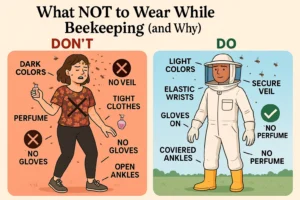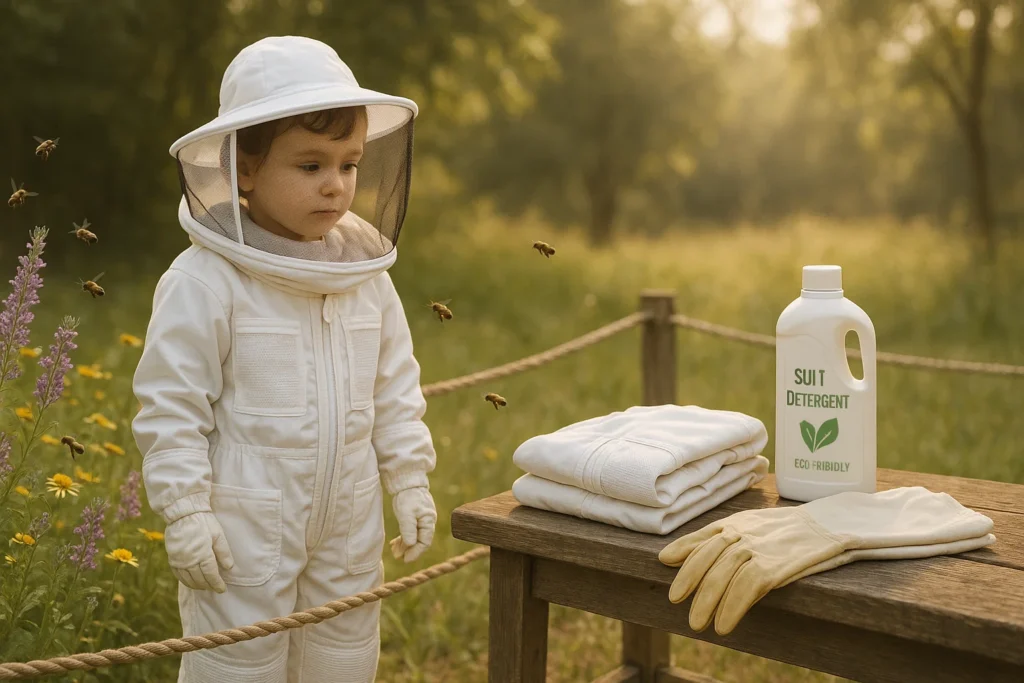
🐝 Gear Up. Stay Safe. Protect the Hive. 🌼
Bees sting prevention is a top concern for beekeepers. A beekeeper in a white suit, pants, gloves, and hat works beside a beehive. They are bent over a hive frame.
Beekeeping is a fulfilling practice that supports biodiversity, enhances crop pollination, and strengthens local ecosystems. For both hobbyists and professionals, safety is a major priority—and that begins with wearing the right protective gear.
If you’ve spent any time around hives, you may have wondered: can bees sting through a bee suit? And if you’re in a region with wasps or hornets, you might also ask: can hornets sting through a bee suit?
These questions are more common than you think, and the answers are important for anyone working with or near stinging insects. This guide explores the science behind bee suit protection, sting risks, and how to choose the right gear for both bees and hornets.
A Brief History of Bee Suits
Bee suits have been part of professional and hobbyist beekeeping for longer than most might assume. While the earliest forms of beekeeping involved minimal protection—often just thick clothing and smoke—modern bee suits began to take shape as beekeeping transitioned into a more formal and widespread agricultural activity.
In those early days, safety was improvised. Beekeepers would wear heavy garments made from available materials to shield themselves during hive inspections. But as the relationship between humans and bees evolved, so too did the understanding of what makes protective gear effective.
The importance of these suits became more apparent as beekeeping evolved into a profession and crucial agricultural activity. The suits were designed to cover the body and protect against stings while still allowing the beekeeper to inspect hives and work with ease. Over time, the design became more refined, incorporating features like netted hoods for visibility, elasticized cuffs to block bees from entering, and full-body coverage that is both breathable and functional.
Today, bee suits are specifically engineered with sting resistance in mind—yet even with all these advancements, stings can still occasionally occur under certain conditions.
Can Bees Sting Through a Bee Suit?
Modern bee suits are designed to be sting-resistant, but not entirely sting-proof. So, the answer is yes—bees can sting through a bee suit, but only in specific situations.
Bee stings may occur when:
In most cases, high-quality suits made with thick cotton or ventilated multi-layered mesh prevent bees from reaching the skin with their stinger. A properly fitting and well-maintained suit minimizes the chance of a sting while providing comfort and confidence during hive work.
Can Hornets Sting Through a Bee Suit?
Hornets pose a greater threat due to their physical strength and behavioral differences. This leads many beekeepers and pest control professionals to ask: can hornets sting through a bee suit?
The unfortunate answer is yes—hornets can sting through a bee suit more easily than honeybees. Their stingers are longer and more robust, allowing them to penetrate some protective clothing, especially if the material is thin or tight against the skin.
Unlike bees, hornets do not lose their stinger after a single attack, which means they can sting multiple times in rapid succession. This makes them more dangerous and harder to deal with in open environments.
For areas prone to hornet activity, it is highly recommended to wear:
When dealing with hornet nests, it’s also wise to limit direct contact and consider consulting a professional exterminator or wildlife expert.
Why Bee Suits Work Most of the Time
Despite their limitations, bee suits remain an essential and effective barrier between you and potential stings. They are designed to offer:
When used properly, a bee suit greatly reduces your chances of being stung, whether you’re managing a small hive or navigating a large apiary.
Advantages and Disadvantages of Bee Suits
White bee suits may be the gold standard in the beekeeping industry, but it’s helpful to understand their pros and cons—especially in relation to sting protection.
Choosing the right suit for your specific conditions—climate, bee species, and potential hornet presence—is key to balancing safety and comfort.
Tips for Choosing the Right Bee Suit
A child wearing a white beekeeping suit, hat, and veil stands next to a roped-off garden, looking at the lush green plants.
Selecting a bee suit is about more than just size and color. Here’s what to keep in mind:
Maintaining your suit is just as important as buying the right one. Wash it regularly, check for holes or thinning fabric, and replace any components showing signs of wear.

The Essential Role of Bee Suits in Sting Protection
Bee suits are more than just clothing—they are a beekeeper’s first line of defense. While it’s true that bees can sting through a bee suit in rare cases, the right gear dramatically lowers that risk. For those in hornet-prone areas, taking extra precautions with reinforced protection is wise.
Whether you’re inspecting brood frames, harvesting honey, or splitting hives, your comfort and safety directly impact your success.
Are you looking for a high-performance bee suit to protect your apiary efforts? Suit up with the ventilated and sting-resistant options available at Dadant & Sons. Explore our collection to find the perfect fit for beekeepers of all ages and experience levels.
